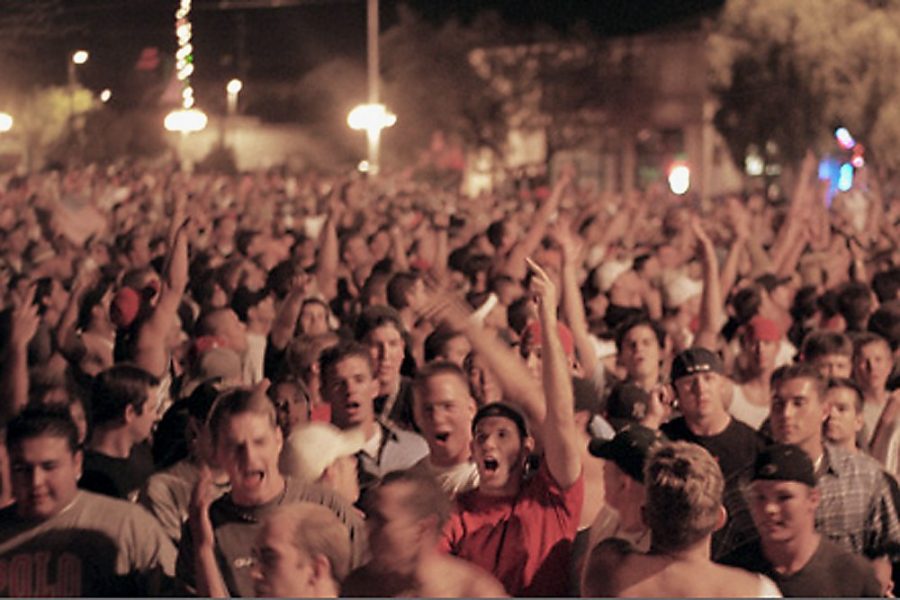After the Arizona men’s basketball team lost the NCAA Championship game in 2001, hundreds of fans poured onto Fourth Avenue, chanting “U of A.” The crowd grew violent, broke shop windows, overturned cars and set fire to buildings and a trailer.
The riots, following the April 2, 2001 NCAA Championship game against Duke University, resulted in massive property damage and 17 arrests and left more than 40 people injured.
With this year’s possibility of the first championship run for the Wildcats since 2001, local law enforcement is bearing down.
The Tucson Police Department and the University of Arizona Police Department are taking steps to prevent possible riots during the NCAA Championships this year.
M. Scot Skinner, a former reporter for the Arizona Daily Star, was on Fourth Avenue the night of the riots in 2001. He drove to Fourth Avenue after hearing about the riots on the nightly news. Skinner said he could see the fires burning from his house on the west side of Tucson.
Skinner recalled that when the unruly fans began to form a mob, many police officers left and the lack of police presence allowed the destruction to escalate.
“The reason why [police] left was to get into their outfits, into their riot gear,” Skinner said. “That was when most of the damage happened.”
Skinner arrived after most of the rioters had dispersed. Upon arrival he saw a nearly abandoned street and a line of police officers in full riot gear approaching him.
“Somebody yelled at me, one of the cops, ‘Turn around, go in the other direction,’” Skinner said. “So I turned around and went in the other direction, and then they shot me.”
Police shot Skinner in the calf with either a rubber bullet or a wooden dowel, two of the non-lethal weapons used by police officers that night. They also used stun grenades and modified shotguns that fired cloth bean bags filled with pellets.
Skinner said that the late arrival of police left dozens of those who had not been in involved in the riots injured, mostly merchants and witnesses waiting for help from law enforcement. He said that many people were unable to understand police commands, which were projected through a megaphone, to disperse. The injured included Jeff Knepper, a then-freshman at the UA who lost an eye when he was struck in the face by a bean bag.
With these events and other instances of riots surrounding past NCAA Championships in mind, TPD is making preparations to deal with potential violent situations. Sgt. Pete Dugan, TPD public information officer, said that TPD constantly trains its Mobile Field Force One unit to work in crowded venues and deal with riots. Dugan said the training is not a reaction to past riots, but that TPD has intensified some training to prepare for the NCAA Tournament.
“We’re not expecting anything to happen,” Dugan said. “But if anything does happen we want units out there that are trained and ready to handle what could happen if crowds get unruly.”
TPD officers who will be on patrol the night of the Championship will use tactics to prevent mobs from forming, including stopping large groups of people from assembling and keeping spectators moving.
“[Officers] are definitely prepared for anything,” Dugan said, “and they are not going to tolerate people doing anything but having fun out there.”
Dugan said there will be approximately 300 uniformed TPD personnel in the university area the night of the championship game, which is scheduled for April 6 in Arlington, Texas. TPD expects assistance from UAPD, as well as from the Arizona Department of Public Safety and the Pima County Sheriff’s Department.
UAPD is meeting today to discuss safety strategies to ensure security on campus. Sgt. Filbert Barrera, UAPD public information officer, said the goal is to keep students protected and prevent possible injury.
Brian Seastone, UAPD chief of police, said UAPD hopes to work with other groups on campus to ensure the celebrations for the basketball games go smoothly, win or lose.
“We are planning for the Final Four and National Championship,” Seastone said. “Not necessarily riots; we’re planning for a good, peaceful celebration.”
A previous version of this article stated that Brian Seastone was a UAPD commander. Seastone is the UAPD chief of police.








